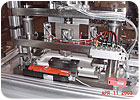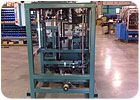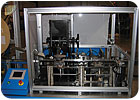Successful automation begins with communication. Here’s what your machine builder needs you to know for a profitable partnership.

If there is a manufacturing company in Camelot, the factory will always have orders to be filled with products that can be delivered on time and sell at a profit. It will always have a trained and motivated workforce available, and will always be able to start up special manufacturing processes as they are needed for a new product.
But where the rest of us live, things go wrong. The order delivery schedule is a series of irregular peaks and valleys, causing sporadic overstaffing, understaffing and missed delivery dates. Workers leave so new people need to be found and trained. The special process equipment is nowhere to be found-because it’s special.
Special machine builders probably can’t help you with factory orders or staffing issues. But special machine builders can help you improve performance and-ultimately-profitability. Becoming “partners in productivity” with your machine builder is the basis for a mutually beneficial relationship, and here’s what your builder needs you to know to make that relationship successful.

Getting Started
The earlier we are involved in your project, the better we can help you design the product for manufacturing and assembly. We have probably already solved problems similar to those that you will encounter in your project. There are dimensioning and tolerancing interrelationships concerning the manufacturing processes, the product materials, the assembly of the product, and the interface of the finished product with other parts or assemblies. We can help you through these issues to ensure the product and processes are compatible.We have manufacturing experience as well as special machine expertise; we can help to plan your processes and workcells. If you want to break your line into several modules, each doing a portion of the total process, we can help you to ensure that your process combinations make sense with respect to material handling, product orientation, process compatibility and rate.
Your Equipment Specification
Please discuss with us what you expect this equipment to do, then document your expectations in a specification so there are no misunderstandings later. Your proprietary information and significant product-specific experience aside, you don’t need to tell us how to design the project. But disclosing the details of the current processes, if any, may help to keep your price down on the new system.
If you have any special requirements, we need to be aware of them at the start of our involvement. Control charts, automatic incoming parts inspection, special in-process inspections, automatic statistical process control, extended qualification protocols, and many other special requirements have associated costs. We need to include these costs in our proposal to you. Finding out about these requirements later could cause project delays, whether for their execution or for the approval by your management of the concomitant additional funds.
If there are any physical restrictions such as floor space, ceiling height, doorway size or building column location, we need to know what they are before we begin to generate our proposal. If, for example, we propose a U-shaped workcell for operator convenience, then learn that you only have a long narrow space available, we will need to requote the project, which may change the price, but will certainly delay the project.
Please tell us the volume requirements for the product that passes through this equipment. If you have tentatively justified the project based on an hourly rate, tell us that. If you have only general, annual volume forecasts, we can work with that-and the available plant hours in your manufacturing year.
In general, if you have specific requirements, tell us in your specification what they are. If not, or if you don’t know what the requirements should be, discuss the project with us, and we will help you determine the parameters of the equipment.

Our Proposal
Our proposal communicates to you our interpretation of your requirements, and describes how we will meet those requirements. We offer several types of proposals. Firm, budgetary, and phased are the most-used.A firm proposal is just that. Based on the scope described in our proposal, we will supply the equipment for the firm price we quote. During the execution of the project, any significant deviations from the original scope can result in price and/or schedule changes.
A budgetary proposal can be appropriate if one or more aspects of your project are not finalized. The decision tree in the sidebar entitled Budgetary vs. Firm Proposal will help you decide which you need. A budgetary proposal is nearly always sufficient for a break-even analysis to choose among production plans. Also, we can generate a budgetary proposal in a fraction of the time-and at a fraction of the cost-required to generate a firm proposal. So, even though we typically do not charge for proposals, please be considerate and don’t ask for a firm proposal when a budgetary proposal will work for your purpose. A budgetary proposal is almost always within 10 percent of what will eventually be the firm price-assuming there are no significant changes to the requirements.
A phased proposal is a good way to approach a project for which you cannot develop a complete specification. It allows the two parties to share the risk, while mitigating the risk for both. Essentially, the project flow is concept, proof of concept, design, build, debug and qualify, and install. Each step-or phase-is addressed individually, and may change the direction for the subsequent phases. For a full description of phased proposals, see my article, “A Low-Risk Approach to High-Risk Projects,” which was published in the February 2007 issue of ASSEMBLY.
A spare parts list and pricing cannot be included in the original proposal for special equipment because the parts list does not exist at the proposal stage. The earliest a recommended spare parts proposal can be generated is during the detailed design of the project.
You may see the operation and maintenance manual quoted on a time and material basis for a good reason-we don’t all have the same vision of a manual. The reality is, a manual can be anything from a few pages listing the real meat of the operation and maintenance tasks, to a full-color, inch-thick tome with photos, line drawings, charts, graphs and detailed instructions. Which level you want determines the price.
The information we include in our proposal is for your use alone. Many times, our advantage in the bidding process is our approach to the project-the intellectual property we bring to the party. We don’t expect you to carry our concepts and proposals to our competition; please don’t bring theirs to us.
Delivery
Delivery lead times start upon our receipt of the purchase order and all of the information we list in our proposal as necessary to start the project, including the down payment. We will acknowledge receipt of your order with an estimated delivery date based on our workload at the time.
Please pay attention to our quoted lead time; it is calculated to be both doable and competitive. If we offer you a lead time of 30 weeks for a 20 week project, our chances of hitting our delivery are about 100 percent, but our competitiveness goes out the window, so we need to be realistic in our lead times.
The lead time we offer in our proposal is an estimate; the delivery date we offer with our order acknowledgement is also an estimate. Many tasks involved in delivering a special machine are not under our direct control, including deliveries from our suppliers. Outside shop workloads, commercial item availability, and OEM item delivery all can affect our delivery to you. You may say that it is our responsibility to choose suppliers that are responsive to our needs, and you would be right. But their workload may change between the time they quote to us and the time we place an order, so their delivery lead time to us may change. And it may be because their supplier has a similar problem with a supplier. Changing suppliers mid-project is seldom an option for us.
Delivery problems are not all generated by suppliers. If you calculate the delivery date from the lead time we quote, and then delay placing your order, we won’t be able to hit that date. If you cause a delay during the project, the end date will most likely slip an amount equal to the initial delay. If you ask us what you can do to get the machine a month earlier, we may respond, “Place the order with us a month earlier.”
Customers sometimes offer to pay overtime to get a machine earlier; save your money. Shortening a carefully generated machine schedule is nearly impossible. The gating item in machine delivery is almost never material lead times, engineering time, or assembly labor-the three items that can sometimes be influenced by an influx of cash. One of the more difficult-to-predict items in a schedule is the completion of the debug process, and we must be allowed to fully debug the process or you won’t be satisfied with the result.
Price and Payment Terms
The payment terms we specify in our proposal are designed to keep our cash-flow relative to your project slightly on the positive side, so we always have operating capital.Please don’t assume there is fat in our price to cover additional requests you might make. Our quoted price covers our expenses and includes a modest profit margin that allows us to keep our prices competitive, and allows us to survive and grow. Our expenses include engineering time, fabrication labor, assembly and debug labor, travel expense, incoming freight, purchasing of commercial and fabricated machine parts, benefits, insurance, taxes, building maintenance, utilities and administrative overhead.
Our quoted price will be held for a finite term. The prices we pay for wages, benefits, materials, parts, services and even taxes are fluid. These prices form the basis of the prices we charge for our products. Please don’t dust off a year-old proposal and assume we will honor it. We may honor it, but we may not be able to.
Design and Build
In our proposal, we described a concept for your project-not the only possible concept-but a concept that we are certain will work. Some changes may be required during the design phase, maybe even as early as our kickoff meeting. A change in the project concept or means of execution of the included functions does not necessarily mean a change in the price. A change in the project scope, however, implies additional or fewer features or functions, and will drive a price change.
Some customers just can’t help themselves; they need to ask, “Have you done this before?” I have never seen the answer to this question affect the project one way or another. We may not have done this particular combination of tasks before, but we know the laws of physics; we apply them daily, and we’re pretty sure they don’t change from job to job. Of course, if you ask us to look at a project that makes use of technology too far removed from our areas of expertise, nuclear physics, for example, we will respectfully decline to quote it.
Design reviews are intended to be an interactive activity; not merely a presentation by us. We are responsible to make this machine function to the requirements, but you should not be a passive partner. You need to understand what you see and hear, question it, suggest improvements, and agree or disagree. Your company is depending on you to bring in a successful project.
We like to hold the design reviews at our facility so we can show you our facility and capabilities, and we can pull in additional people from our staff, if necessary, to explain the details of a technical issue. We also have the requisite computer-based equipment here to make the review a satisfying experience.
There are practical limits to our resources and tools for doing business. We do not have all of the CAD software packages that are on the market; we will use one of our standard packages, and convert the resultant documentation to your desired format if necessary.
Debug, Qualification and Installation
You need to consider expenses in addition to the equipment you want to purchase from us. One such expense is travel to design reviews. Others include the equipment delivery, and product components and material to be used for debug and qualification. We may need significant quantities of your product components and material for developing the OEM subassemblies such as feeders, welders, markers and crimpers that go into your project. Components used for feeder development, for example, will not be suitable for reuse as debug components for the machine.We may turn a significant quantity of your product materials into scrap during the debug phase. Most material can only pass through the new process for the debug efforts one time and-because it was changed by the process-it becomes scrap. Debug is one of the more difficult parts of an automation project to estimate, so the quantity of product material we require may change.
If we need to follow a particularly stringent qualification and documentation protocol, we need to be aware of the requirements before we quote the project. In the absence of your protocol, we will write our own, intended to provide evidence that the equipment was executed to, and performs to, the requirements.
Installation is sometimes quoted as installation supervision or installation support, meaning that we will ensure that your personnel do the installation, but to our requirements. There is a reason that we don’t normally firm-quote installation. Your people may very well have other responsibilities to meet during installation. Their absence at a critical time could affect the installation schedule and, if our people are waiting for your people to do something, our people are not being productive.
Safety
We do not know all of the safety codes for your company, your factory and your municipality. However, your machine will be safe to operate and maintain, because we build our products to meet national codes, such as those established by the National Fluid Power Association or the Occupational Safety and Health Administration. We will depend on you to be familiar with the local codes. If you are aware of an instance where the local codes are more stringent than the national codes, it is your responsibility to tell us about it before we quote your project.
Spare Parts
All machines will eventually need maintenance and replacement parts. We don’t normally stock parts for the special equipment we build, so you need to stock parts to minimize your downtime. The earliest we can generate and price a recommended spare parts list is during the detailed design phase.
To generate a recommended spare parts list, we need to know your tolerance for downtime. We need to know what period of time you expect your spares to cover-how long can you tolerate the machine being down awaiting a part you don’t keep in stock? For example, if the delivery for a shear punch is two weeks, and you can’t afford two weeks downtime waiting for the punch to arrive, you should keep the punch in stock.
Production Rate
The machine we build will run at or above the gross rate we quote, and will meet the short-term efficiency numbers in our proposal. The long-term efficiency and overall equipment effectiveness are up to you. See the sidebar entitled Overall Equipment Effectiveness for a sample calculation.
We use sound engineering principles and quality components to build good machines that meet your requirements from the time they are installed on your production floor. You can only expect to realize your productivity goals over the long term if the equipment is operated by properly trained and motivated individuals.
Warranty and Training
There are hundreds of parts in some of the machines we build, and they have never been assembled in exactly the same combination before. An occasional part failure should not be a surprise, nor does a failure have to be a catastrophic event.
Please understand that all failures are not warranty issues; indeed, some are not machine issues. Some failure scenarios are: commercial part fault, commercial part applied incorrectly, a software or controls glitch, output rate deterioration, product quality deterioration, operator error and improper maintenance. The first three are definitely warranty issues. The rest are the result of improper training or inattention to the task at hand.
Personnel training issues that are responsible for machine failures can be traced to second- or lower-generation training. It has been shown repeatedly that the farther one gets from the original trainer, the less effective the training. If the personnel that we trained for you transfer or leave, you may want to ask us to come in and train your current workforce.
Help Us to Help You
Many of us in the special automation industry who have survived the recent manufacturing shakeups do an excellent job of supplying high-quality processing systems at reasonable prices, but we need your help for us to help you. Get us involved early. Tell us what you expect to gain from your new equipment purchase, treat our relationship as a true partnership, and take the initiative in maintaining the productivity of your new equipment. And through it all, let’s continue to work together and use our collective innovation to keep the manufacturing base in the United States strong and agile.